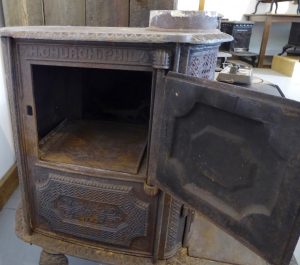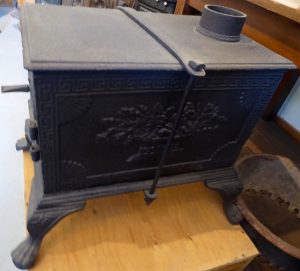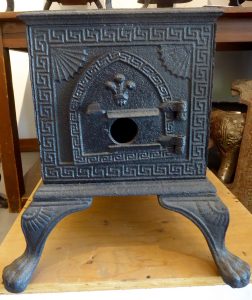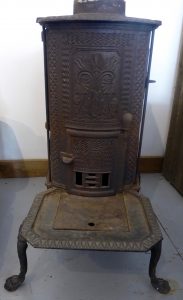Cook Stove Revolution of the 1800s
I bought a new cook stove recently. It displays all the latest technological, in this case digital, innovations of the current day. When a surface element is turned on, a fan blows air forward and upward toward the person using the range. An acquaintance with the same stove model returned it to the store, believing that the air would in turn worsen health conditions.
This experience reminds me of the story of Mrs. Chancy whose husband invented a stove. It surpassed in complexity all others on the market. His wife didn’t like the stove, and scolded him about his invention.
“Really Mr. Chancy! As if it were a matter of course that we should get people to suit our stoves, instead of stoves to suit our people” (Brewer, 2000, p.67).
The episode of the Chancys happened around the 1840s and 180 years later the designers of cook stoves may still be influenced more by technological possibilities than a deep understanding of the people who use the stoves! Could it be that this problem persists because cook stoves are seldom studied and researched? Brewer (2000) claims that cook stoves are “one of the most significant yet least understood artifacts in American history” (p. xiii).
A search of the literature on cook stoves in Canada and the United States found few studies reported, thus supporting Brewer’s claim. In this post, I will share some of the main ideas gleaned from three sources and in the next few blog posts look more closely at cook stoves from the past in British Columbia and Canada.
Brewer examined art, fiction, domestic manuals, newspapers and private journals of the time to study the transition of American culture, particularly in the Northeastern states, from fireplace to cook stove. During the 1700s the iron industry in the United States took off and manufacturers introduced the first stove in the 1760s. At the time they were considered appropriate for heating public buildings but Americans were slow to adopt them as a home appliance for cooking food.
In the early 1800s many patents were granted for cook stoves, beginning the rush to develop an efficient and functional cook stove that could gain wide acceptance. But there were numerous obstacles. There was considerable angst beginning in the mid 1800s about the impact of the stove on home life. Some people believed that the disagreeable odours, bad air and smoke from stoves were harmful to health, causing headaches, giddiness and stupor. Others, mainly men, sentimentalized the open fire of the old fireplaces, believing that adopting a cook stove would ruin domestic life and social intercourse that occurred in the glow of an open fire. Others believed the energy emanating from an open fire nurtured the human spirit (Brewer, 2000).
Women were eager to adopt the cook stove. They had long endured the hot, smoky and heavy labour of open hearth cooking and suffered “hearth death” that up to the seventeenth century was a principal cause of death among women, second only to childbirth (Field in Culinary Historians of Ontario, 1998). Women also frequently burned holes in their aprons and skirts from the sparks of the open fires. The style of eating changed as a result of this technology. Meals prepared in open hearth cooking were often one-pot meals whereas stoves permitted many dishes to be cooked simultaneously.
Efficient use of fuel was one argument for adopting a wood cook stove as wood became scarce and costly. This also required that wood had to be cut and chopped into smaller pieces for burning than had been required for fireplaces.
There were definite advantages, disadvantages and challenges that came with adopting cook stoves for food preparation. What height should they be? One answer was found in the step stove that provided different heights. The enduring problem was temperature management that is, how to maintain the temperature required for satisfactory baking and cooking. One solution was a stove with a rotating top that could rotate in position over the firebox. Another was a rotating firebox that could be positioned differently under the potholes.
Despite the opposition to stoves in the mid-1800s, both wealthy and poor families bought the appliance in increasing numbers. As iron became less costly through technological improvements, stoves became less expensive and were affordable for more people. Stoves were becoming common in the Midwest as well as the eastern United States and as settlers moved west, many took their stoves with them.
Eva MacDonald (2005) notes that the earliest Canadian heating stove worked in conjunction with an existing fireplace chimney. It consisted of five interlocking cast iron plates that formed a box supported by short legs and the open side placed against the wall of the fireplace chimney. While primarily a heating stove, the box shape permitted heating of a pot or kettle on the top surface. MacDonald states, “By the mid-eighteenth century, the St. Maurice Iron Works in Quebec was manufacturing six-plate cast iron box stoves, which eventually became free-standing through the addition of a stove pipe” (p. 4).
An example of a five plate cast iron stove can be seen at historic O’Keefe Ranch outside of Vernon BC where a large stove collection can be viewed (okeeferanch.ca). Many visitors don’t realize the extent of the Ranch collection but if one follows the “Stoves” signs to a building out back of the main house, a fascinating collection of heating and cooking stoves can be viewed.
In mid-nineteenth century British Columbia, as European and American settlers moved in, stove manufacturers opened shop in Victoria and other emerging towns. One stove in the O’Keefe Ranch collection labeled “E Church Phil” may have originated in Philadelphia 
View of side oven (Photo by Ken Mather)and been packed in by early miners or settlers. It is a small but versatile stove that was found in Yale BC. It disassembles, has two burners for heating a kettle and pot, an oven that is accessible from both sides and would also heat a small cabin. A highly practical appliance for the time!
The introduction and use of the wood burning cook stove extended over almost two centuries, from the mid 1700s to mid 1900s. Interest frequently resurges where and whenever self-sufficiency movements take hold. The cook stove now represents a nostalgic longing for simpler times, much as the open hearth fire did during the time that the cook stove sought acceptance. Technologies associated with home and family living are imbued with emotional, psychological, moral and spiritual meanings that appliance innovators should heed. The challenge of accepting new cooking technologies repeated with the introduction of the microwave oven, the convection oven, inductive cooking and the more recent fan that blows toward the user when a burner is turned on.
References
Brewer, Priscilla J. (2000) From fireplace to cook stove, technology and the domestic ideal in America. Syracuse NY: Syracuse University Press.
Culinary Historians of Ontario (1998). Home is Where the Hearth is…, No. 15, p. 1.
MacDonald, Eva M. (2005). How the Cooking Stove Transformed the Kitchen in Pre-confederation Ontario. Culinary Chronicles, No. 43, pp. 3 – 10.
Thank you to Ken Mather, curator emeritus at O’Keefe Ranch for photos and information.



